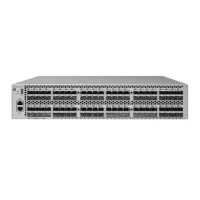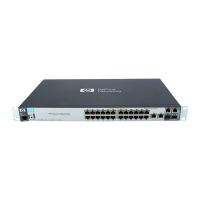Fabric OS Administrator’s Guide 559
53-1002745-02
Buffer credit management
23
• If QoS is not enabled:
(Reserved Buffer for Distance Y) = (X * LinkSpeed / 2) + 6
where
X = the distance determined in step 1 (in km).
LinkSpeed = the speed of the link determined in step 2.
6 = the number of buffer credits reserved for fabric services, multicast, and broadcast
traffic. This number is static.
14 = the number of buffer credits reserved for QoS. This number is static.
With the answers provided in steps 1 and 2, insert the numbers into the appropriate formula.
The formula should read as follows:
(50 km * 2 Gbps / 2) + 6 = 56 buffers, which is the number of buffers reserved for distance.
Below are additional examples using different speeds, all based on a distance of 50 km. The
distances and speeds are variables that can change depending on how your network is set up:
• If you have a distance of 50 km at 1 Gbps then, (50 km * 1 Gbps / 2) + 6 = 31 buffers
• If you have a distance of 50 km at 2 Gbps then, (50 km * 2 Gbps / 2) + 6 = 56 buffers
• If you have a distance of 50 km at 4 Gbps then, (50 km * 4 Gbps / 2) + 6 = 106 buffers
• If you have a distance of 50 km at 8 Gbps then, (50 km * 8 Gbps / 2) + 6 = 206 buffers
• If you have a distance of 50 km at 10 Gbps then, (50 km * 10 Gbps / 2) +6 = 256 buffers
• If you have a distance of 50 km at 16 Gbps then, (50 km * 16 Gbps / 2) + 6 = 406 buffers
Example
Consider the Brocade 300, which has a single 24-port port group and a total of 676 buffer credits
for that port group. The maximum remaining number of buffer credits for the port group, after each
port reserves its eight buffer credits, is as follows:
676 – (24 * 8) = 484 unreserved buffer credits
where
24 = the number of user ports in a port group retrieved from Table 83 on page 563
8 = the number of reserved credits for each user port
676 = the number of buffer credits available in the port group
If you allocate the entire 484 + 8 (8 for the reserved buffers already allocated to that user port) =
492 buffers to a single port, you can calculate the maximum single-port extended distance
supported:
Maximum Distance X (in km) = (BufferCredits + 6) * 2 / LinkSpeed
498 km = (492 + 6 buffers for Fabric Services) * 2 / 2 Gbps
How many 50-km ports can you configure?
If you have a distance of 50 km at 8 Gbps, then 484 / (206 – 8) = 2 ports.
The numbers used are as follows:
• 484 — the total number of unreserved buffer credits
• 206 — buffer credits needed for 50 km @ 8 Gbps (as calculated previously

